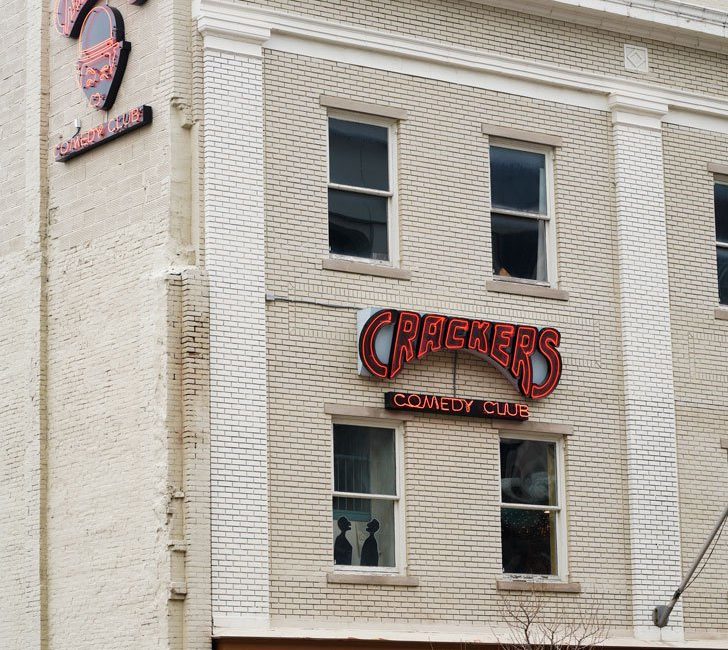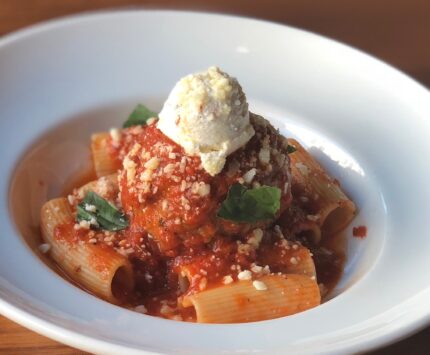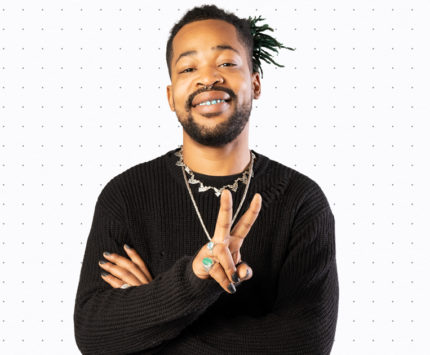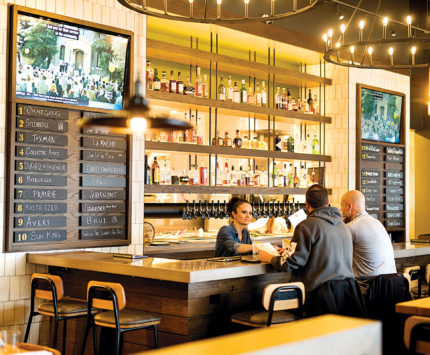
Is Indy’s Comedy Scene Dead?
Ruth-Anne Herber, the long-time owner and operator of Crackers, was sitting in the lobby of her downtown club trying not to cry. It was a gray morning in late October, and she’d been holding back tears for the past 48 hours, ever since the last comedian stepped off the brick-walled stage at Crackers Broad Ripple for the final time. She’d had too much to do, too many things to take care of, to stop and dwell on just how damned sad this all was, how she wasn’t just closing a comedy club, but saying goodbye to a piece of herself.
Herber had run the club at the corner of College and Broad Ripple avenues, upstairs, next to The Vogue, since 1999, when Crackers moved from Keystone at the Crossing back to its original Broad Ripple location. She’d been there on her hands and knees laying the mosaic tile in the lobby, had helped redesign the interior showroom. She raised her daughter at the club, pushed her there in the stroller, fed her in the back office. And when diagnosed with Stage 3 melanoma, the best treatment Herber received was coming into the club on the weekends, sitting in the back, and just laughing her ass off. Literally saved her life, she swears. The last thing she wanted to do was close the Broad Ripple location.
But she couldn’t ignore the writing on the wall. Herber could see the size of the crowds, knew the size of the checks she was cutting at the end of a weekend—she could put two and two together. The market was stretched too thin. She was stretched too thin. Something had to give.
Chris Bowers, owner of Morty’s Comedy Joint on Indy’s north side, knows exactly what Herber was feeling in that moment. The two club owners don’t have much love for one another—not many rivals do—but if there’s one thing that they can find common ground on, something they can empathize with each other over, it’s that running a comedy club in Indianapolis, in today’s entertainment landscape, is damned difficult, and only getting harder.
Bowers, himself a comedian, bought Morty’s with his old college roommate, Tony Deardorff, after it had closed eight years ago. He likes to joke, half-seriously, that he did so solely to give himself more stage time.
“We’ve been behind the eight ball from Day One,” he said, a few days after Herber announced the closing of Crackers Broad Ripple, which at the time was about five miles south of Morty’s 96th Street location (now it’s on 82nd Street, east of The Fashion Mall). “We’ve never been in a good spot.”
Bowers preferred to keep a positive spin on things, though, even while admitting that there had been talk of Morty’s closing its doors if business didn’t bounce back enough to sustain them through the summer, a notoriously slow time of year for Midwest comedy clubs.
“To be honest, we’re not in any more trouble now than the day we started. It’s just a matter of, you know, kick the can down the road a little further each day and hope that we can always…” He trails off, leaving the thought of not making payroll, or the mortgage, unspoken. “It’s funny, my personal finances have kind of trained me to do this.” He laughs. “I joke that one day I’m going to write a book called How to Stave Off Elimination.”
What’s really funny, though, in a sad sort of ironic way, is that while comedy clubs like Crackers and Morty’s struggle to keep the lights on, stand-up comedy, culturally speaking, has never been more popular. We are in the midst of a second Comedy Boom. Everyone is saying so—The Washington Post went so far as calling this a “golden age” for stand-up, proclaiming comics the “new rock stars.”
It’s hard to disagree—just look at all the stand-up specials on Netflix. Back in 2006, HBO, then the go-to place for stand-up specials, put out four of them (starring Cedric The Entertainer, Lewis Black, Dennis Miller and Dane Cook, if you were curious). Fast-forward to 2017, and Netflix produced 52, one for every week of the year, an investment totaling in the hundreds of millions of dollars (Chris Rock and Dave Chappelle alone got $20 million per special). It’s not just big names, either, who are pulling in buckets of cash—did you know Sebastian Maniscalco took home more money in 2017, $15 million, than Derek Carr, the NFL’s highest-paid QB? Do you even know who Sebastian Maniscalco is?
There have been ripple effects from these booming times felt on the ground across the country, notably in the explosion of the independent, DIY comedy scene—in Indianapolis, the amateur circuit is thriving, with more local comedians putting on shows than ever before. It’s a situation, conventional wisdom suggests, that should be good for the local comedy clubs—more exposure and more enthusiasm should equate to more people wanting to watch comedy. But it hasn’t. In fact, it’s had the opposite effect, a problem that both Herber and Bowers know all too well.
**** **** ****
There was a time, back in the ’80s and early ’90s—during the original comedy boom—when Indianapolis was a hub for stand-up. Indy had more comedy clubs per capita than just about any city in the country; at one point there were five, all within 15 minutes of downtown, all bringing in quality talent three, four, sometimes five nights a week.
It helped that Indianapolis was a centralized Midwest location—they don’t call it the Crossroads of America for nothing. But more important, Indy was home to The Bob & Tom Show. Back then—this was before satellite radio and podcasts and streaming services—everyone listened to the radio, and in Indianapolis, most of them listened to Bob & Tom; at its peak, the show reached almost a quarter of all radio listeners in the market, an unheard-of saturation point in today’s fractured age.
The relationship was a symbiotic one: The radio show received free content from a guest comedian, and the owner of the club he or she was performing at later got an hour of free advertising on the most listened-to morning radio show in the city.
It was a good time to be in the comedy game, and for about a decade, those good times rolled. But then came the inevitable crash, the bursting of the bubble. Plenty of factors were to blame: Reaganomics, cable TV specials, network sitcoms creating a whole new class of superstar comedians like Roseanne Barr, Tim Allen, and Jerry Seinfeld, who started selling out theaters instead of packing crowds into comedy clubs. But mostly it was overexposure, oversaturation—too many bad comics, and too many clubs willing to host them. Audiences got burned out, and all over the country, comedy clubs began going belly-up.
Here in Indy it was a slow, Darwinian process. A decade of survival of the fittest, at the end of which only Morty’s and Crackers—with its two locations—were left standing.
**** **** ****
A week after the closing of Crackers Broad Ripple, Herber found herself back at the club, moving out the last of her stuff. There was still a mess of randomly filled boxes piled up in the lobby, and she only had a few hours to hand over the key and exit the building for good. She was still sad about the whole thing, still wished it could have turned out differently. But more than anything, she was just ready to be done with it all. Ready to stop looking at the past and start focusing on the future.
“It’s getting harder and harder to get people out of their living rooms,” she says, when asked about the shifting landscape of comedy. “Netflix has brought awareness to stand-up comedy, but it also makes people think they can stay home and watch it on their big, expensive TVs.”
It’s not the same experience, she says, watching stand-up from the comfort of your own couch versus being enveloped in the energy of a comedy club. There’s something magical that happens when you’re packed into a dark room with strangers watching live comedy, a sort of electrical current of energy that flows from the stage and into the crowd, creating a living, breathing moment. The question is, how do you change that? How do you convince people that stand-up comedy, like a rock concert, has to be seen live to be truly experienced?
Herber shook her head, pointed to an eight-foot neon-light outline of Charlie Chaplin’s face and head—the club’s logo—and explained how carefully it needs to be handled on the way to the elevator. She didn’t have an answer.
“The days of just going by a radio station, and if the comic is funny, you sell out, are gone,” Herber says, more than a little wistfully, packing up a box of autographed photos that once hung on a wall in the lobby.
Bowers doesn’t have an answer, either. This boom isn’t like last time, he says, where one minute there were zero comedy clubs between the coasts, and the next, a thousand. The original comedy boom was about people wanting to see comedy, and, subsequently, people wanting to capitalize on them. It was a comedy club boom.
“The comedy boom we’re in right now,” he explains, “is people wanting to do comedy. Comedy as a spectator sport is not booming.”
It’s not just the Netflix factor that’s killing clubs. The landscape has shifted so dramatically in the past five years, it has actually flipped the balance of power: Club owners were once the gatekeepers, the source of stage time, paychecks, and brand-boosting morning radio appearance. Now, with the rise of independent, DIY comedy, coupled with the social media factor—allowing comedians to organically cultivate a following by connecting directly with fans—there’s no longer a need for a built-in club crowd, or for a club owner to arrange a spot on a morning radio show, which is a rapidly dwindling force anyway—Bob & Tom reaches about 7 percent of radio listeners in the market these days.
In fact, comedians don’t need the club, period.
“It used to be,” Bowers says, “that famous comedians would spend X number of years in the clubs becoming famous comedians.” But now, he says, “The minute anybody gets any fame, they start playing rock clubs, they start playing little theaters. Ten years ago, if you were a theater comic, that meant you could sell 4,000 tickets. Now, Live Nation has venues in Indianapolis of all different sizes: 500-seat venues, 700-seat venues, 1,100-seat venues.”
Bowers cites T.J. Miller as an example (this was before Miller was accused of sexual assault, back when he was still considered one of stand-up’s ascendant young stars). When he came through Indianapolis in 2016, Miller didn’t play Crackers or Morty’s—he played The Vogue, right next door to Crackers. Sold the place out, too. Now, if he’d played one of the clubs, spread his audience over three nights, those profits could have been used to pay for the next three comedians, people who aren’t yet household names. The next ascendant young star, in other words. It’s trickle-down comedy, and it’s how the business has operated since Reagan was in office. But not anymore.
“The reason comics do that,” Bowers says, “is because clubs have treated them poorly for a long time.” Bowers knows from experience. “I’ve played clubs that didn’t take care of me—they weren’t nice to me, they didn’t pay any attention to me, and that sucks. And so when a comic hits, the instinct is not, Oh, I’m going to go make THAT guy a bunch of money. That’s not what you think. You think—I’m going to make all the money for myself. Which I get. I just don’t think comics understand how important their role is to clubs surviving.”
**** **** ****
It’s been more than five months since Crackers Broad Ripple closed, and while the dust has begun to settle on Indy’s comedy scene, there’s still a cloud of doubt surrounding the future of its comedy clubs. For Bowers and his partners at Morty’s, it’s been a roller coaster ride—they’ve gone from talking about permanently closing, to discussing the possibility of re-branding and becoming an events center, to selling out 34 shows since November. To put that number in perspective, they had all of two sellouts during the first 10 months of 2017.
Bowers points to multiple reasons for the recent success. Morty’s has partnered with a promotional group, Straight Up Stupid, who have been bringing in a big-name crossover act a few times a month, and Bowers speculates that the club is pulling some of the northside crowd that used to go to Crackers Broad Ripple. The biggest difference, however, is Morty’s new booking method.
“We’ve switched to more of a celebrity-based booking strategy,” Bowers explains, citing the club’s March lineup of Gilbert Gottfried, Joel McHale, Lonnie Love, and John Caparulo. It’s a risky, high-wire act of a strategy—one that could go very bad, very quickly—but one that Bowers hopes can see the club through the long days of the slow summer months.
“We’ll see if we can continue our momentum,” he says, noting that March has gone well so far, despite the warming weather and NCAA tournament.
Herber, on the other hand, has no plans to change her model. It’s a strategy that has worked well for her over the last 18 years, and she sees no reason to mix things up now. The approach has some critics within the scene, who say that what worked two decades ago isn’t a recipe for success in the future. They argue that club owners need to adapt to the changing times, particularly Herber, who prides herself on running an “old-school” operation. Some suggest diversifying, sprinkling in other forms of entertainment to keep the food and drink sales coming in on days when the club is typically closed, while others think that a partnership with the independent scene might help attract a younger, hipper generation of comedy fans.
Herber disagrees. “It’s all about sticking to what I know, which is comedy, and continuing to book the future stars of tomorrow,” she says, summing up her philosophy going forward.
She feels energized, she says, rejuvenated now that all of her time and resources are focused solely on the downtown Crackers location, with its beautiful new showroom, designed to the exact specifications of the Broad Ripple club, and great Mass Ave location, which has provided a boom in walk-in business.
“It was the best thing I could have done,” she says of closing down Broad Ripple to focus on downtown. “It was the future for us.”
As for the space at the corner of College and Broad Ripple avenues, upstairs, next to The Vogue; it’s still available, ready-made for comedy. And if you put your ear close enough to the ground, you can hear rumors regarding potential occupants, whispers about people with dreams of starting their own club, to capitalize on these booming times.
It’s an idea that both Herber and Bowers find, quite literally, laughable.






